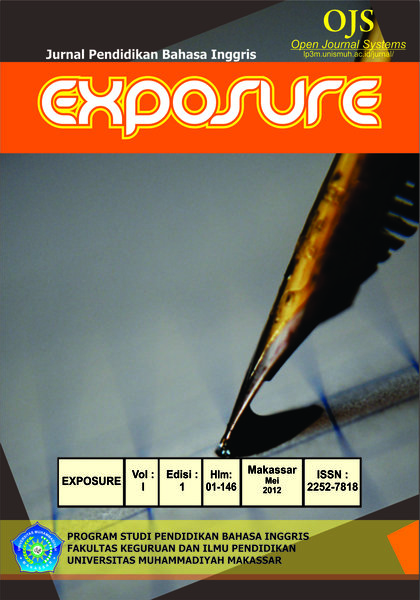BRAIN-SKETCHING TECHNIQUE FOR DESCRIPTIVE TEXT IN IMPROVE WRITING SKILL AT SENIOR HIGH SCHOOL OF UNISMUH MAKASSAR
DOI:
https://doi.org/10.26618/exposure.v1i1.763Abstrak
The research aimed at improving the ability of the Eleventh-grade students of Senior High School of Unismuh Makassar in writing descriptive text using the Brain-Sketching Technique. For the purpose, it employed Classroom Action Research in which the researcher worked in planning, implementation, observation, and reflection on the data collected from the teaching and learning process and the students' writing products. The method of this research is Classroom Action Research that consists of two cycles. One cycle consisted of four meetings. It means that there were eight meetings for two cycles. This classroom action research was done in Senior High School of Unismuh Makassar for English subject. As subjects in this research are class XI IPA 2 in 2012-2013 academic years which consists of 26 students. Those consisted of 14 women and 12 men. The instruments used were writing test and observation sheet. The study was conducted in a diagnostic test, cycle one and cycles two, each cycle was carried out in four meetings. The objective of the research was intended to know the improvement of the students’ writing ability after using Brain-Sketching Technique at the Eleventh-grade students of Senior High School of Unismuh Makassar. The findings indicated that using Brain-Sketching Technique could improve the students' ability in writing descriptive text. Before giving implementation the researcher gave the students diagnostic test and the mean score of diagnostic test was 63.90 as classification “fairly good”. Then the researcher conducted the first cycle and the second cycles, and the result showed that the students' scores in the first and second cycles improved. In the first cycle, the mean score of students was 67.22 as classification “fairly good”, meanwhile the mean score of students in the second cycle was 71.41 as classification “good. It means that the improvement of students’ writing ability from D-Test to cycle I was 5.21%, the cycle I to cycle II was 6.22%, D- test to cycle II was 11.73%.
Keywords: Brain-Sketching, Technique, Descriptive, Text, Writing.
Referensi
Adel Stein English & Jean G. Pival. 1976. The writing commitment. New york: Hartcourt Brace Java Novich. Inc.
Bram, Barli. 1995. Write Well. Improving Writing Skill. Yogyakarta: Kanisius.
Breveton. 1982. A Plan for Writing Skills. New York: CBS College Publishing.
Byrne, Donn.1990. In Wiwintisari Mahis (2009). Teaching Writing Skills. London and New York: Longman Group UK Limited.
Cunningham, P.M. (1994). Classrooms That Work. N.Y.: Harper Collins.
Dalle, Basri. 2010. Fundamentals of Research Methodology. Makassar: Universitas Muhammadiyah Makassar.
Echols, John M., and Hassan Shadily. 2003. Kamus Indonesia Inggris. PT. Gramedia. Jakarta.
Jacobs et al (1981:31). “Components in Writing”.
Littell, McDougal. 2004. Basic Skill in English. States of America: McDougal, Litell and Company.
Quirk, Randolp, et al; A Grammar of Contemporary English, Longman, London, 1972.
Oshima and Hogue (1997: 2); The Oxford Learner’s Pocket Dictionary (2005:502).
Tiro, Muhammad Arif and Baharuddin Ilyas. 2002. Statistika Terapan untuk Ilmu Ekonomi dan Ilmu Sosial. Makassar: Andira Publisher.
VanGundy AB Techniques of structured problem solving (second edition). Van Nostrand Reinhold, New York (1988).
Waldhorn, Arthur and Arthur Zeiger, English Made Simple, Cadillac Publishing Co., New York, 1954.
Weaver, Constance. 1996. Teaching Grammar in Context. Portsmouth, NH: Boynton/Cook Heinemann.
Wishon, George E. 1980. Let’s Write English. New York: Revised Edition.
Unduhan
Diterbitkan
Terbitan
Bagian
Lisensi
Authors who publish with this journal agree to the following terms:
In order to assure the highest standards for published articles, a peer review policy is applied. In pursue of the compliance with academic standards, all parties involved in the publishing process (the authors, the editors and the editorial board and the reviewers) agree to meet the responsibilities stated below in accordance to the Journal publication ethics and malpractice statement.
Duties of Authors:
- The author(s) warrant that the submitted article is an original work, which has not been previously published, and that they have obtained an agreement from any co-author(s) prior to the manuscript’s submission;
- The author(s) should not submit articles describing essentially the same research to more than one journal;
- The authors(s) make certain that the manuscript meets the terms of the Manuscript Submission Guideline regarding appropriate academic citation and that no copyright infringement occurs;
- The authors(s) should inform the editors about any conflict of interests and report any errors they subsequently, discover in their manuscript.
Duties of Editors and the Editorial Board:
- The editors, together with the editorial board, are responsible for deciding upon the publication or rejection of the submitted manuscripts based only on their originality, significance, and relevance to the domains of the journal;
- The editors evaluate the manuscripts compliance with academic criteria, the domains of the journal and the guidelines;
- The editors must at all times respect the confidentiality of any information pertaining to the submitted manuscripts;
- The editors assign the review of each manuscript to two reviewers chosen according to their domains of expertise. The editors must take into account any conflict of interest reported by the authors and the reviewers.
- The editors must ensure that the comments and recommendations of the reviewers are sent to the author(s) in due time and that the manuscripts are returned to the editors, who take the final decision to publish them or not.
Authors are permitted and encouraged to post online a pre-publication manuscript (but not the Publisher’s final formatted PDF version of the Work) in institutional repositories or on their Websites prior to and during the submission process, as it can lead to productive exchanges, as well as earlier and greater citation of published work (see The Effect of Open Access). Any such posting made before acceptance and publication of the Work shall be updated upon publication to include a reference to the Publisher-assigned DOI (Digital Object Identifier) and a link to the online abstract for the final published Work in the Journal.

